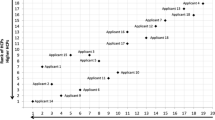Abstract
Inserm is the only French public research institution entirely dedicated to human health. Inserm supports research across the biomedical spectrum in all major disease areas, from fundamental lab-based science to clinical trials. To translate its scientist’s findings into tangible health benefits, Inserm has its own affiliated company, Inserm Transfert, which works with industry. Since 2001, Inserm has been setting up on-line file management software for the evaluation of researchers and laboratories, called EVA (www.eva.inserm.fr). EVA includes all grant applications, assessment reports, evaluation grading evaluation forms and includes automated bibliometric indicator software that enables calculating, for example, the number of publications, journal impact factors, number of citations, citation index, and number of the Top 1 publications for each researcher of the teams. The indicators take into account research fields, the year of publications, and the author’s position among the participants. Bibliometrics is now considered a tool for science policy providing indicators to measure productivity and scientific quality, thereby supplying a basis for evaluating and orienting R&D. It is also a potential tool for evaluation. It is neutral, allows comparative (national and international) assessment, and may select papers in the forefront in all fields. For each team, bibliometric indicators are calculated for all researchers with permanent or long-term positions (3–5 years). The use of bibliometric indicators requires great vigilance, but according to our experience they enrich the committee’s debates without any doubt. We present an analysis of the data of 600 research teams evaluated in 2007-008.
Similar content being viewed by others
References
Aksnes DW, Taxt RE (2004) Peer reviews and bibliometric indicators: a comparative study at a Norwegian university. Res Evaluation 13: 33-1
Cherubini P (2008) Impact factor fever. Science 322: 191
Garfield E (2006) The history and meaning of the journal impact factor. JAMA 295: 90-3
Hirsch JE (2007) Does the H index have predictive power?. Proc Natl Acad Sci USA 104: 19193-9198
Jansen D, Wald A, Franke K et al (2007) Third party research funding and performance in research. On the effects of institutional conditions on research performance of teams. Kolner Z Soziol Sozialpsychol 59: 125
Junquera B, Mitre M (2007) Value of bibliometric analysis for research policy: A case study of Spanish research into innovation and technology management. Scientometrics 71: 443-54
Moed HF, van Leeuwen TN (1996) Impact factors can mislead. Nature 381: 186
Nederhof AJ (2008) Policy impact of bibliometric rankings of research performance of departments and individuals in economics. Scientometrics 74: 163-74
Opthof T (1997) Sense and nonsense about the impact factor. Cardiovasc Res 33: 1-
Seglen PO (1997) Why the impact factor of journals should not be used for evaluating research. BMJ 314: 498-02
Simons K (2008) The misused impact factor. Science 322: 165
Author information
Authors and Affiliations
Corresponding author
About this article
Cite this article
Haeffner-Cavaillon, N., Graillot-Gak, C. The use of bibliometric indicators to help peer-review assessment. Arch. Immunol. Ther. Exp. 57, 33–38 (2009). https://doi.org/10.1007/s00005-009-0004-2
Received:
Accepted:
Published:
Issue Date:
DOI: https://doi.org/10.1007/s00005-009-0004-2




